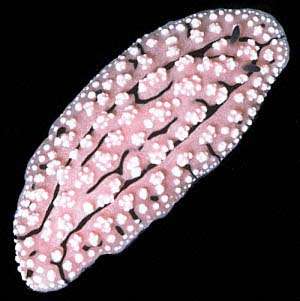
Phyllidiopsis krempfi
Pruvot-Fol, 1957
Order: NUDIBRANCHIA
Suborder: DORIDINA
Family: Phyllidiidae
DISTRIBUTION
Known from Vietnam, the Andaman Sea (eastern Indian Ocean) and Java, Indonesia, [But records on the Forum suggest a wide Indo=West Pacific distribution]
PHOTO
16m, Phi Phi Is., southern Thailand, November 1989, Dorsal view of 52mm animal, PHOTO: D.J. Brunckhorst. (Brunckhorst, 1993: Plate 8A).
Notes from Brunckhorst,1993: Large species characterised by predominantly pink coloration, and broad based multicompound tubercles with paler apices. Apart from two primary longitudinal black lines, other black lines of variable size occur irregularly. Rhinophores pink on anterior face and around base, black on apex and posterior face.
Two other species with similarly coloured rhinophores:
Phyllidiopsis pipeki, which has bright pink colouration and consistently two straight black longitudinal lines only, rounded white tubercles (not multicompound).
Phyllidiopsis fissuratus, which is also pink and black but is extremely tuberculate, with very tall compound and coalesced tubercles with deep black valleys between. It also has a translucent raised rim around the raised rhinophore pockets and a smooth tall raised pink anal papilla.
Reference:
• Brunckhorst, D.J. (1993) The systematics and phylogeny of Phyllidiid Nudibranchs (Doridoidea). Records of the Australian Museum, Supplement 16: 1-107.
Rudman, W.B., 1998 (December 12) Phyllidiopsis krempfi Pruvot-Fol, 1957. [In] Sea Slug Forum. Australian Museum, Sydney. Available from http://www.seaslugforum.net/find/phylkrem
Related messages
Phyllidiopsis krempfi from the Philippines
November 26, 2009
From: Mirjam Broos
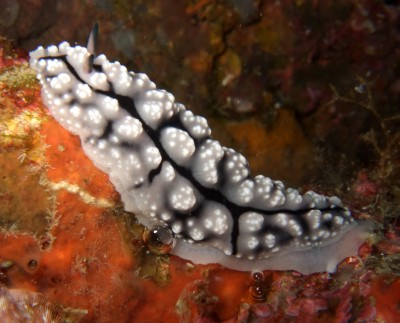
Dear Bill,
I was quite surprised to find out that there are only a few messages on your site according Phyllidiopsis pipeki. I think we have found it quite a few times but maybe I'm wrong and is this another kind of slug?
Locality: Cabilao, South Point, Philippines, 10 april 2008. Photographer: Geert Prast.
best regards
Mirjam
mirjam.broos@planet.nl

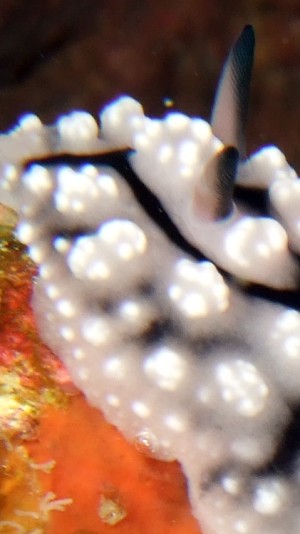
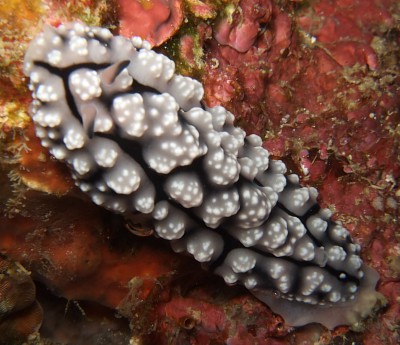
Dear Mirjam,
This is Phyllidiopsis krempfi. The multicompound tubercles with white tips are quite characteristic and as you will see on the Fact Sheet, separate it from P. pipeki and P. fissuratus, the two other species with similarly coloured rhinophores.
In the left close-up photo we can see the anus very clearly. Perhaps not the most attractive feature to highlight, but its presence here in the dorsal midline near the posterior end, links these animals, which have lost the typical dorid dorsal circlet of gills, to other dorids. In most dorids the anus is hard to see because it is obscured by a circlet of gills which surround it.
Best wishes,
Bill Rudman
Phyllidiopsis krempfi? from Malaysia
September 8, 2006
From: Kenneth Yong
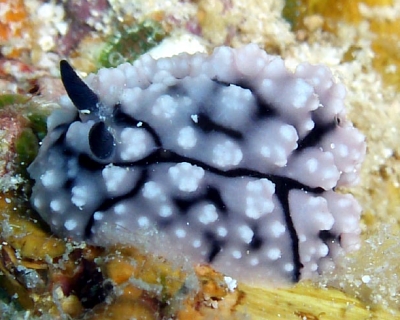
Hello,
Is this Phyllidiopsis krempfi?
Locality: Tanjung Nibong, Lang Tengah Island, 15 m, Malaysia, South China Sea, 27 July 2006. Length: 5 cm. Photographer: Kenneth Yong.
Thanks much for the help.
Cordially,
Kenneth
k.yong@tiscali.it
Yong, K., 2006 (Sep 8) Phyllidiopsis krempfi? from Malaysia. [Message in] Sea Slug Forum. Australian Museum, Sydney. Available from http://www.seaslugforum.net/find/17658Dear Kenneth,
It certainly looks like P. krempfi, but my only doubt is that in species of Phyllidiopsis the rhinophores are usually multi- or bi-coloured and never completely black. On the other hand, species of Phyllidiella, have black rhinophores. In P. krempfi, the rhinophores are usually black with a pink band up the anterior side, wide at the base and getting narrower towards the tip. The rhinophores are half retracted in your animal, but I would have expected to see a bit of pink. On the other hand I don't know of a species of Phyllidiella that looks like this.
Best wishes,
Bill Rudman
Phyllidiopsis krempfi from Sth Africa
February 6, 2004
From: Charles Rowe

Hi Bill,
Here is another nudi which I photographed in January at Sodwana in Kwa Zulu Natal, South Africa.
Sodwana - 7 Mile Reef 4 January 2004
Best wishes
Charles Rowe
bumff@mweb.co.za
Rowe, C., 2004 (Feb 6) Phyllidiopsis krempfi from Sth Africa. [Message in] Sea Slug Forum. Australian Museum, Sydney. Available from http://www.seaslugforum.net/find/12130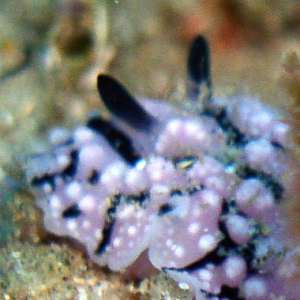
Dear Charles,
This is Phyllidiopsis krempfi. One distinguishing feature is that the front of the rhinophores are pink. Unfortunately that's not easy to see from the angle this photo was taken but you can see a bit of it in the close-up alongside.
Best wishes
Bill Rudman
Phyllidiopsis krempfi from Mayotte
December 17, 2003
From: Marina Poddubetskaia
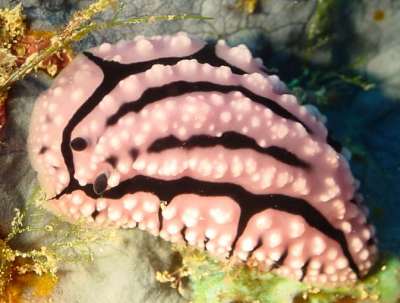
Dear Bill,
Could you confirm that this phyllidiid is Phyllidiopsis krempfi, please? I found it without moving on this nice sponge. So, it could be its potential food. I took the close-up of its rhinophores in the tank and it's incredible how different the animal colour can be, depending on the used light.
Date: November 04, 2003
Location: Mayotte Island, France, Indian Ocean
Site: Passe en S, buoy n° 8bis
Depth: 21m
Size: 35mm
Cheers,
Marina.
nembro@nembro.info
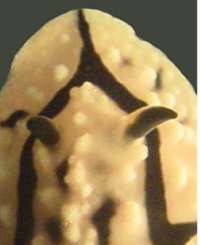
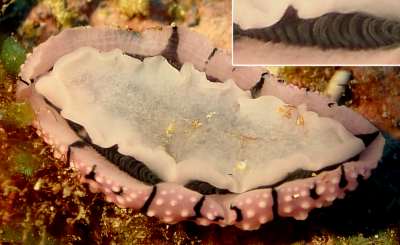
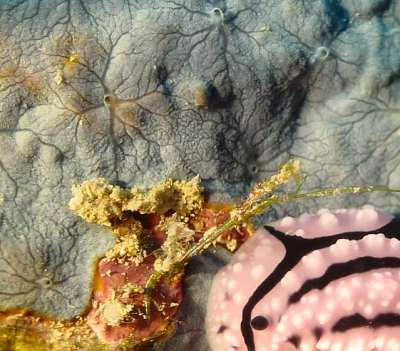
Thanks Marina
I am pretty sure this is Phyllidiopsis krempfi. The general colour and tubercle arrangment fits, as does the colour on the rhinophores with the black being restricted to the posterior edge. It's good to get a photo of the ventral surface. I have included an inset of some of the blackish gills. I've also included a close-up alongside, of part of the sponge. I guess you would have noticed if it was actually feeding when you moved it so all we can do it keep a nte of it and see if we find this species associated with the same sponge in the future
Best wishes
Bill Rudman
Phyllidiopsis krempfi from Solomon Ids
January 23, 2003
From: Scott Johnson
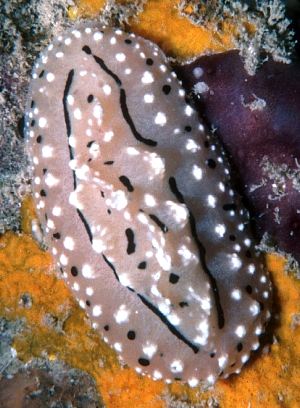
Hi Bill,
To accompany the photo of Phyllidiella rudmani I sent earlier, here is the somewhat similar Phyllidiopsis krempfi, also from the Solomon Islands. This specimen was found at Boneghi on Guadalcanal. It is similar to the image by Bruce Potter from Karumolun in the Solomons' Russell Islands. I have a similar, yet I think different animal also from Karumolun that I will send in a separate message.
Scott
johnson@kmr.LL.mit.edu
Johnson, S., 2003 (Jan 23) Phyllidiopsis krempfi from Solomon Ids. [Message in] Sea Slug Forum. Australian Museum, Sydney. Available from http://www.seaslugforum.net/find/8908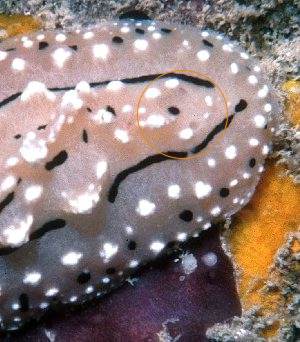
Thanks Scott,
I'm glad I'm not the only one who has problems with some of the phyllidiids. I have copied alongside what I take to be the anterior end of this beast. If so, I can see a pair of white spots with a translucent greyish patch in front of each one. I can interpret this as a two white tubercles with a translucent spot in front, or white tipped rhinophore clubs on a translucent stalk. Could you check any other photos you have to see if there is a more reasonable interpretation?
Cheers,
Bill Rudman
Phyllidiopsis krempfi from Indonesia
January 8, 2003
From: Ginette Allard
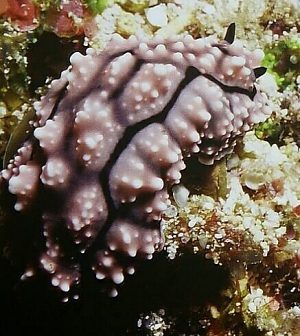
Is this Phyllidia elegans?
Photo from Frédéric André in Siladen (Sulawesi) July 2002.
Ginette Allard
gigiallard@aol.com
Allard, G., 2003 (Jan 8) Phyllidiopsis krempfi from Indonesia. [Message in] Sea Slug Forum. Australian Museum, Sydney. Available from http://www.seaslugforum.net/find/8748Dear Ginette,
Although it looks something like Phyllidia elegans, that species has yellow rhinophores. I suspect this is Phyllidiopsis krempfi, but I would need to see the front of the rhinophores to be sure. In this species the front of the rhinophores is pink.
Best wishes,
Bill Rudman
Phyllidiella rudmani? from Solomons
November 19, 2002
From: Bruce Potter

Dear Bill,
Have I finally found Phyllidiella rudmani? I spent a weekend diving in the Russell Islands (Solomon Islands), and on a dive site called Carumolun, I found this fellow at about 12 meters on a vertical wall.
It was about 30mm long.
Regards
Bruce Potter.
bruce.potter@adventist.org.sb
Potter, B., 2002 (Nov 19) Phyllidiella rudmani? from Solomons. [Message in] Sea Slug Forum. Australian Museum, Sydney. Available from http://www.seaslugforum.net/find/8407Dear Bruce,
Full marks for trying. I as I said one other time, it would be really nice if someone could find some unambiguous specimens of P. rudmani. Unfortunately this is not one of them. This is almost certainly Phyllidiopsis krempfi. Although a bit difficult to see in this photo, the black line down each side, join in front of the rhinophores in P. krempfi. Although it is a bit broken in this photo, in P. rudmani the black line on each side runs out and down to the mantle edge anteriorly. Also in P. rudmani the top half of the rhinophore club is black and the lower half is white or pinkish. In this animal, like in P. krempfi the black pigment covers the tip of the rhinophore club and runs down the posterior side, leaving the anterior pink. Also this animal has multicompound tubercles which are whiter at tip, another P. krempfi feature.
Sorry I can't give you better news,
Cheers,
Bill Rudman
Phyllidiopsis krempfi from Indonesia
October 2, 2002
From: Olivia
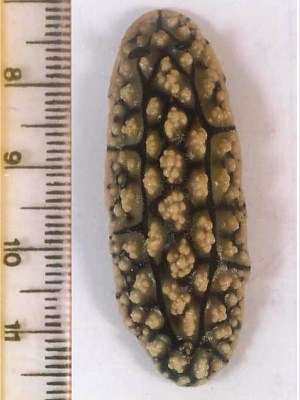
Dear Bill,
I found this spesimen in 17 islands near Flores Island, Indonesia. Could you help me to identify it please?
Dive site: 17 islands, Riung, near Flores island, Indonesia
Date: October, 2001
Depth: 3-7 metres
Olivia
Indonesia
olivia_inigue@yahoo.com
Olivia, 2002 (Oct 2) Phyllidiopsis krempfi from Indonesia. [Message in] Sea Slug Forum. Australian Museum, Sydney. Available from http://www.seaslugforum.net/find/8102Dear Olivia,
From the general shape and arrangement of the tubercles and what's left of the colour pattern, I would say this is Phyllidopsis krempfi.
Best wishes,
Bill Rudman
Phyllidiopsis krempfi from Malaysia
July 5, 2002
From: Kheong Sann Chan
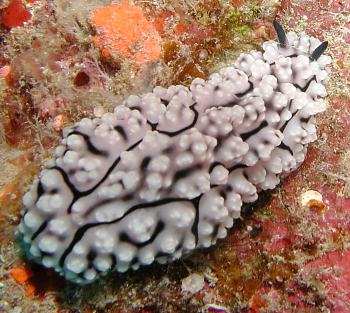

Dear Bill,
Here is another species from Pulau Dayang off the east coast of west Malaysia.
Location: Dayang, Dayang Channel
Date: 8 June, 1130
Depth: 10m
Kheong.
kschan@mail.dsi.nus.edu.sg
Chan, K.S., 2002 (Jul 5) Phyllidiopsis krempfi from Malaysia. [Message in] Sea Slug Forum. Australian Museum, Sydney. Available from http://www.seaslugforum.net/find/7243Dear Kheong,
This is Phyllidiopsis krempfi. One characteristic of this species which you can see in the close-up is the colour of the rhinophores - pink at the front and with a black tip and black down the posterior side. It also has a pinkish tinge and black streaks between the compound tubercles.
Best wishes,
Bill Rudman
Phyllidiopsis krempfi from East Africa
May 23, 2002
From: Bernard Picton
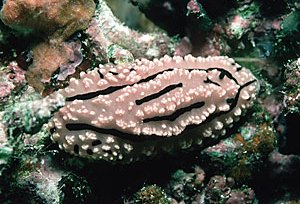

Hi Bill,
It's quiet this week so I've got round to looking through pictures of nudibranchs and trying to put names on things. I have some range extensions to East Africa for several species including this record of what I think is Phyllidiopsis krempfi. These are from Pemba Island where I spent a week diving in Feb 1999 from the boat Kisiwani - the skipper is keen on nudibranchs and had a portfolio of pictures which enthused some of our party so I had some willing "spotters".
The specimens were large, 30-40 mm and I saw several individuals.
Cheers
Bernard
bernard.picton.um@nics.gov.uk
Picton, B. , 2002 (May 23) Phyllidiopsis krempfi from East Africa. [Message in] Sea Slug Forum. Australian Museum, Sydney. Available from http://www.seaslugforum.net/find/6466Thanks Bernard,
It certainly looks like P. krempfi to me, which would certainly be an extension to the western side of the Indian Ocean. If your message concerning
Best wishes,
Bill Rudman
Phyllidiopsis krempfi from Fiji
February 1, 2001
From: Mary Jane Adams
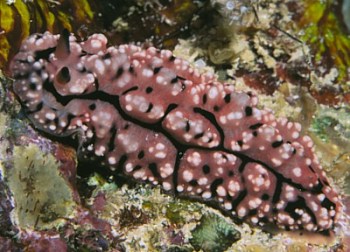
Hi Bill,
I found this nudibranch on a coral reef in northeastern Vitu Levu, Fiji in May, 1997. It was 44 mm long. I did not record the depth. My best guess is Phyllidiopsis fissuratus. I can't see the typical long anal papilla in the photo though. What do you think?
Thanks,
Mary Jane
divepng@yahoo.com
Adams, M.J., 2001 (Feb 1) Phyllidiopsis krempfi from Fiji. [Message in] Sea Slug Forum. Australian Museum, Sydney. Available from http://www.seaslugforum.net/find/3631Dear Mary Jane,
I think this is Phyllidiopsis krempfi. Phyllidiopsis fissuratus and Phyllidiopsis krempfi are very similar in colour and shape but in P. fissuratus the tubercles are packed closely together, are uniformly pink all over, and the mantle is black. another feature I can check in your photo is the rhinophores, which in P. fissuratus are pink with a black posterior line.
In your photo the tubercles are not closely packed, their tips are a much paler pink and the mantle is pink with black lines, some of which are very short - all characters of P. krempfi. Another feature is the colour of the rhinophores which is pink, with a black tip and black posterior band down the club and stalk.
It is sometimes difficult in photos to be sure, because there are characters we can't check, but I am pretty sure this is P. krempfi.
Best wishes,
Bill Rudman
A mystery phyllidiid from Indonesia
January 2, 2001
From: Yasman
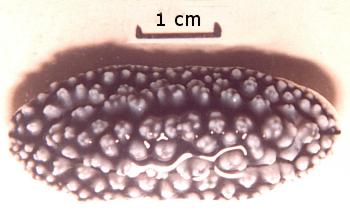
Dear Bill,
I am confused about this species. I have two specimens. One has separated oral tentacle which is typical Phyllidia or Phyllidiella but the other has unseparated oral tentacle which is typical of the genus Phyllidiopsis. From external morphology, it looks like Phyllidiopsis fissuratus which I have already sent you a message and photo. But its black background color is more dominant. It has a black line forming a circle in the middle of notum, which joins with a line anteriorly and posteriorly. It lacks the line which extends perpendicularly to mantle margin as can be found in Phyllidiopsis fissuratus. What do you think?
Best regards,
Yasman
y.yasman@mailcity.com
Yasman, 2001 (Jan 2) A mystery phyllidiid from Indonesia. [Message in] Sea Slug Forum. Australian Museum, Sydney. Available from http://www.seaslugforum.net/find/3346Dear Yasman,
Sometimes a photo is not enough. I suspect the photo is of Phyllidiopsis krempfi and the other animal with non-fused oral tentacles is Phyllidiella pustulosa, but that is just a guess as I haven't seen the specimens. As I said in your earlier message, I think the species you identify as P. fissuratus is probably P. krempfi.
Best wishes,
Bill Rudman.
Phyllidiopsis krempfi from Indonesia
January 1, 2001
From: Yasman
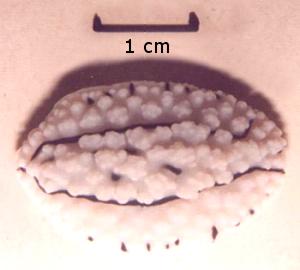
Dear Bill,
Here is a photo of Phyllidiopsis krempfi I found at depth of 40 feets in Karang Lebar Atoll, Thousand Islands, Indonesia.
See you again.
Regards,
Yasman
y.yasman@mailcity.com
Yasman, 2001 (Jan 1) Phyllidiopsis krempfi from Indonesia. [Message in] Sea Slug Forum. Australian Museum, Sydney. Available from http://www.seaslugforum.net/find/3343Thanks Yasman,
Bill Rudman
Phyllidiopsis krempfi (?) from Indonesia
January 1, 2001
From: Yasman
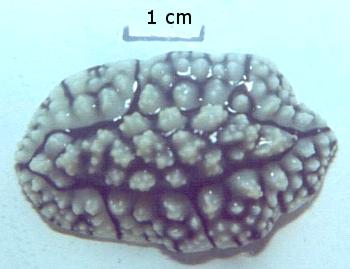
Dear Sir,
I thought this species may be Phyllidiopsis fissuratus. I found it at depth of 40-60 feets in Karang Lebar Atoll, Thousand Islands, Indonesia. Is that right?
Many thanks.
Best regards,
Yasman
y.yasman@mailcity.com
Yasman, 2001 (Jan 1) Phyllidiopsis krempfi (?) from Indonesia. [Message in] Sea Slug Forum. Australian Museum, Sydney. Available from http://www.seaslugforum.net/find/3344Dear Yasman,
I think your animal is probably Phyllidiopsis krempfi. The compound tubercles are more typical of that species. In your photo the tubercles appear very crowded but I suspect that is because the animal is partially contracted out of water.
Best wishes,
Bill Rudman.
Phyllidiopsis krempfi? from Philippines
June 17, 2000
From: Erwin Koehler
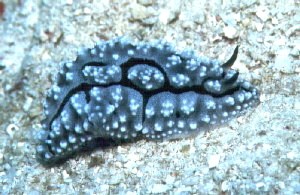
Dear Bill,
I think this a variant of Phyllidiopsis pipeki. It is from the Philippines, Cebu Is., divesite "Loos 2", March 2000, depth 19 m, size approx. 5 cm.
This photo is by Fred Vogt.
Erwin.
Medslugs.Koehler@t-online.de
Koehler, E., 2000 (Jun 17) Phyllidiopsis krempfi? from Philippines. [Message in] Sea Slug Forum. Australian Museum, Sydney. Available from http://www.seaslugforum.net/find/2571Dear Erwin,
There are two species it resembles, Phyllidiopsis pipeki and Phyllidiopsis krempfi. It differs from both in being a grey-blue rather than pink but maybe this is similar to the green/pink colour change in Phyllidiella pustulosa.
In Brunckhorst's review he specifically separates P. krempfi and P. pipeki on the nature of the black lines on the mantle. "P. pipeki .... consistently has two straight black lateral lines (but no others as in the present species)...". P. krempfi also can have some black spots and short black rays extending to the mantle edge as in this photo.
On balance I think this is a grey colour form of P. krempfi. Have a look at some of Clay Bryce's photos from Western Australia showing what I think is colour variation in this species.
Best wishes,
Bill Rudman.
Phyllidiopsis krempfi from Thailand
April 19, 2000
From: Narongpon Sittithaweepat
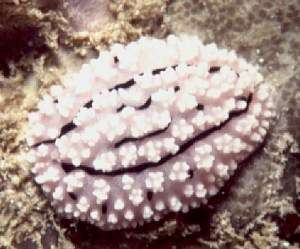
Dear Bill
I can't identify this nudibranch. I found it at Surin Island, Thailand. Photo by Dr. Thon Thamrongnawasawat. I don't record date and depth.
Thank you
Narongpon Sittithaweepat
chromodorid@thaimail.com
Sittithaweepat, N., 2000 (Apr 19) Phyllidiopsis krempfi from Thailand. [Message in] Sea Slug Forum. Australian Museum, Sydney. Available from http://www.seaslugforum.net/find/2250Dear Narongpon,
This is Phyllidiopsis krempfi, which was first described from Vietnam [not Thailand as suggested by Brunckhorst (1993)], and is known also from Thailand and Java in Indonesia.
Best wishes,
Bill Rudman.
Phyllidiopsis krempfi? from Sulawesi
February 16, 2000
From: Lindsay Warren
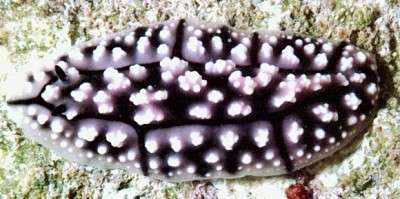
Dear Bill
Please find attached a shot of what I think might be a Phyllidiopsis krempfi which I found on 17 September 1999 at a depth of 86 ft on dead coral and fine algae on patch reef surrounded by sand at the bottom of a wall. L: 36 mm. Tukang Besi, SE Sulawesi, Indonesia. [Operation Wallacea]
The white capped pustules have a second layer of smaller pustules on them. The retractile lamellate rhinophores have translucent white front edge and base while the back and tip are black. Overall background mantle colour is pale pink. Photo: Lindsay Warren.
I have looked through Brunckhorst's work since coming back and only realised then the importance of noting details of foot and gill colours / markings. If only I had known beforehand!
All the best
Lindsay Warren
100014.2112@compuserve.com
Warren, L., 2000 (Feb 16) Phyllidiopsis krempfi? from Sulawesi. [Message in] Sea Slug Forum. Australian Museum, Sydney. Available from http://www.seaslugforum.net/find/1834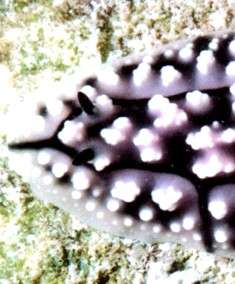
Dear Lindsay,
Yes I think this is probably a dark form of P. krempfi.
Best wishes,
Bill Rudman.
Phyllidiopsis krempfi from Japan
December 16, 1999
From: Yasuhiro Shirai
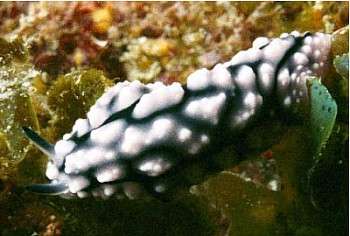
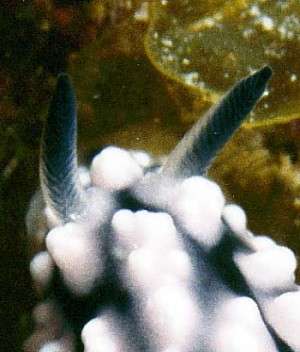
Dear Bill,
Thank you for your quick reply every time.
This time, I have attached 2 files. For a long time I thought this animal was Phyllidiella pustulosa but I realized that this animal's rhinophores is different from P. pustulosa's one.
Could you please tell me its name.
Data:
Location:around the coral reef at Kusimoto (Japan) Length: 30mm. Water temperature: 26.5C. September 1999. Depth: 16.5m. Found crawling on seaweed.
Best regards,
Yasuhiro Shirai
http://www.e-net.or.jp/user/yasuhiro/
yasuhiro@e-net.or.jp
Shirai, Y., 1999 (Dec 16) Phyllidiopsis krempfi from Japan. [Message in] Sea Slug Forum. Australian Museum, Sydney. Available from http://www.seaslugforum.net/find/1677Dear Yasuhiro,
I am pretty sure that this is Phyllidiopsis krempfi. If you have a look at some of the other messages below yours on this page you will see other close-up pictures of the very characteristic rhinophores. I thnk this is the first time it has been reported from Japan.
Best wishes,
Bill Rudman.
Phyllidiopsis krempfi? from NW Australia
February 5, 1999
From: Clay Bryce
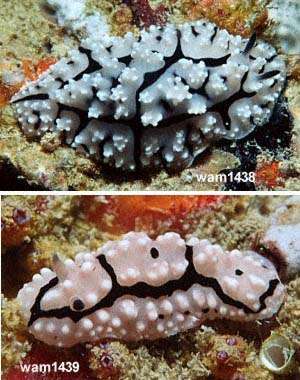
Hi Bill,
Hope your are keeping well. I am in the process of wading through the material from the last four trips. I have attached some images (at least I hope it works) of 6 phyllidiids that are giving me some trouble. Would you mind taking a look?
I have tham all down as P. cf. krempfi (complex)!!?? but I am not happy with the identifications. They are all from the Kimberley region of northwestern Australia.
Feel free to put them into the Forum.
WA1438: Cassini Island, North side. 13o56'S: 125o38'E. Depth 30 - 4.5m Drop-off to 30m. Shallows subject to high tidal current with stunted corals. Encrusting sponges in caves and underhangs of drop-off. Collected: 18/9/98 Length: 5.5cm
WA1439: Same data as 1438 Length: 2.5cm
WA1399: Hibernia Reef, North side: 11o58'S: 123o19E, Depth: 8 - 27m Slope, brocken coral rubble with scattered live coral and encrusting sponges. Collected: 11/9/98 Length: 4cm.
WA1401: Same data Length: 3.5cm
WA1402: Same data Length: Top: 3.5cm. Bottom: 5cm.
WA1405: Same data Length: 2.5cm
All the best,
Clay Bryce
Western Australian Museum
Perth.
brycec@museum.wa.gov.au


Clay,
I'm glad to see you have a scanning system at work! I've had a look at the images and am pretty sure they are all P.krempfi (sensu Brunckhorst). I make the following comments:
WA1402: I presume they are all the same. The large one looks a bit like Phyllidiopsis burni but the top specimen, at least, has pink and black rhinos. (P. burni has black rhinos) and the other possibility, Phyllidiopsis fissuratus has large long anal papilla which I can't see in your photos.
WA1439. The black tipped rhinos aren't right for P. krempfi but it is probably a
juvenile.? Possibly the black down the posterior edge doesn't appear until they're bigger.
Although David Brunckhorst's monograph is a great advance in our understanding of the family, I am sure he would be the first to acknowledge that we still have a lot to learn about the phyllidiids. One good way is to have a look at the variation. For that reason I am happy to put up more pictures of what is probably all one species.
Best wishes,
Bill Rudman.
Phyllidiopsis from the Philippines
December 12, 1998
From: Erwin Koehler
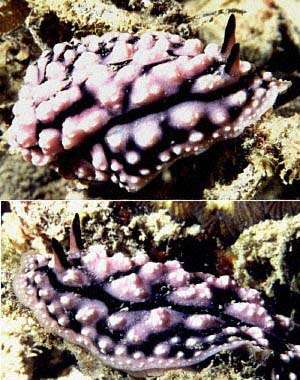

Dear Bill,
I'm back from 5 weeks diving at Panglao and Negros, Philippines and have a lot of shots of slugs (more than 1000). Some IDs are NO IDEA, with others I'm not very sure, most are done. The first photos show (as I guess) Phyllidiella pustulosa (Cuvier, 1804) with some unusual rhinopores. The shots were done at the dive site BBC (Bohol Beach Club),
Panglao, depth 18 m, date Oct. 29th
Erwin
Erwin Koehler
E.Koehler@deutschepost.de
Koehler, E., 1998 (Dec 12) Phyllidiopsis from the Philippines. [Message in] Sea Slug Forum. Australian Museum, Sydney. Available from http://www.seaslugforum.net/find/376Dear Erwin,
Welcome to the world of the troublesome Phyllidiidae. It looks like Phyllidiella pustulosa but the rhinophores are a giveaway. In Phyllidiella they are always uniform black. According to Brunckhorst (1993) three species of Phyllidiopsis have these pink rhinophores with a black posterior stripe. One of these, Phyllidiopsis krempfi is I think your animal. I have put pictures and notes of the other two on the site for comparison. They are Phyllidiopsis fissuratus and Phyllidiopsis pipeki.
Thanks for keeping us informed of your interesting finds,
Bill Rudman.
